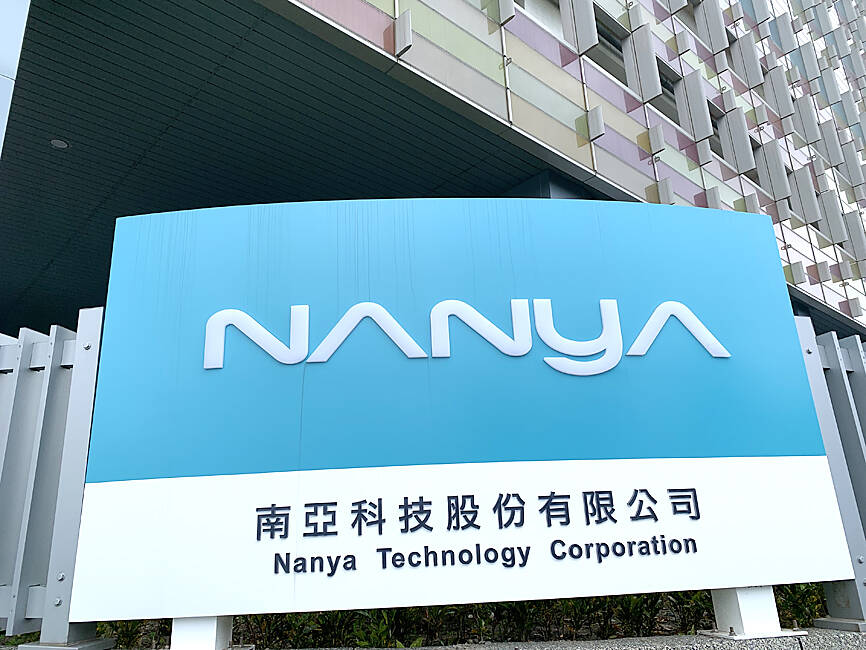DRAM chipmaker Nanya Technology Corp (南亞科技) yesterday said the US tariffs would not have a devastating effect on the company, as it is working with customers to mitigate cost increases during the 90-day reprieve of US President Donald Trump’s “reciprocal” tariffs.
Despite a baseline duty of 10 percent that remains in place under Trump’s tariff policy, the company only exports a limited portion of its chips directly to the US, although US customers accounted for a significant portion of its revenue, Nanya Technology president Lee Pei-ing (李培英) told an online earnings conference.
The latest development is already a positive twist as compared with a week ago, Lee said.

Photo: Grace Hung, Taipei Times
“Our customers are seeking to reduce the tariff impact. We are also cooperating with them to make some adjustments,” he said.
US-based Micron Technology Inc started to impose a tariff-related surcharge on some products such as memory modules and solid-state drives from Wednesday, Reuters reported on Tuesday.
Nanya Technology has no plans to hike DRAM prices for the time being, Lee said.
The company expects improving market demand to drive DRAM prices higher this quarter, as China’s stimulus packages are spurring sales of consumer electronics, Lee said.
DRAM prices last quarter dropped by a low single-digit percentage sequentially, he said.
On top of that, robust demand for high-bandwidth memory and high-density DDR5 DRAM chips are helping cut standard DRAM chip supply from the world’s major memorychip manufacturers and supply chain inventory, he said.
The anticipated DRAM price upticks are expected to help support the company’s gross margin to return to the positive territory this quarter, from minus-15 percent last quarter, Lee said, adding that the price increases would have been higher without the disturbance of US tariffs.
The company attributed the lackluster gross margin last quarter to the production transition from 20-nanometer technology to its second generation of 10-nanometer-class technology, which resulted in a lower yield rate.
The technology upgrade is necessary, as it allows the company to produce high-density and high-speed DDR5 DRAM chips used in cloud-based servers and edge devices beyond standard DRAM chips, the company said.
With the yield rate improving, the adverse effect would fade at the end of this quarter, it said.
Nonetheless, it would take time to see the company’s bottom line return to the black, although the situation would improve quarter by quarter this year, Lee said.
Nanya Technology yesterday reported that losses last quarter widened to NT$1.94 billion (US$59 million), compared with NT$1.57 billion the previous quarter. That marked a 10th consecutive quarter of losses.
The company plans to spend NT$19.6 billion in capital expenditure this year, up 21.7 percent from NT$16.1 billion last year.

STEEP DECLINE: Yesterday’s drop was the third-steepest in its history, the steepest being Monday’s drop in the wake of the tariff announcement on Wednesday last week Taiwanese stocks continued their heavy sell-off yesterday, as concerns over US tariffs and unwinding of leveraged bets weighed on the market. The benchmark TAIEX plunged 1,068.19 points, or 5.79 percent, to 17,391.76, notching the biggest drop among Asian peers as it hit a 15-month low. The decline came even after the government on late Tuesday authorized the NT$500 billion (US$15.2 billion) National Stabilization Fund (國安基金) to step in to buoy the market amid investors’ worries over tariffs imposed by US President Donald Trump. Yesterday’s decline was the third-steepest in its history, trailing only the declines of 2,065.87 points on Monday and

TAKING STOCK: A Taiwanese cookware firm in Vietnam urged customers to assess inventory or place orders early so shipments can reach the US while tariffs are paused Taiwanese businesses in Vietnam are exploring alternatives after the White House imposed a 46 percent import duty on Vietnamese goods, following US President Donald Trump’s announcement of “reciprocal” tariffs on the US’ trading partners. Lo Shih-liang (羅世良), chairman of Brico Industry Co (裕茂工業), a Taiwanese company that manufactures cast iron cookware and stove components in Vietnam, said that more than 40 percent of his business was tied to the US market, describing the constant US policy shifts as an emotional roller coaster. “I work during the day and stay up all night watching the news. I’ve been following US news until 3am

Six years ago, LVMH’s billionaire CEO Bernard Arnault and US President Donald Trump cut the blue ribbon on a factory in rural Texas that would make designer handbags for Louis Vuitton, one of the world’s best-known luxury brands. However, since the high-profile opening, the factory has faced a host of problems limiting production, 11 former Louis Vuitton employees said. The site has consistently ranked among the worst-performing for Louis Vuitton globally, “significantly” underperforming other facilities, said three former Louis Vuitton workers and a senior industry source, who cited internal rankings shared with staff. The plant’s problems — which have not

TARIFF CONCERNS: The chipmaker cited global uncertainty from US tariffs and a weakening economic outlook, but said its Singapore expansion remains on track Vanguard International Semiconductor Corp (世界先進), a foundry service provider specializing in producing power management and display driver chips, yesterday withdrew its full-year revenue projection of moderate growth for this year, as escalating US tariff tensions raised uncertainty and concern about a potential economic recession. The Hsinchu-based chipmaker in February said revenues this year would grow mildly from last year based on improving supply chain inventory levels and market demand. At the time, it also anticipated gradual quarter revenue growth. However, the US’ sweeping tariff policy has upended the industry’s supply chains and weakened economic prospects for the world economy, it said. “Now